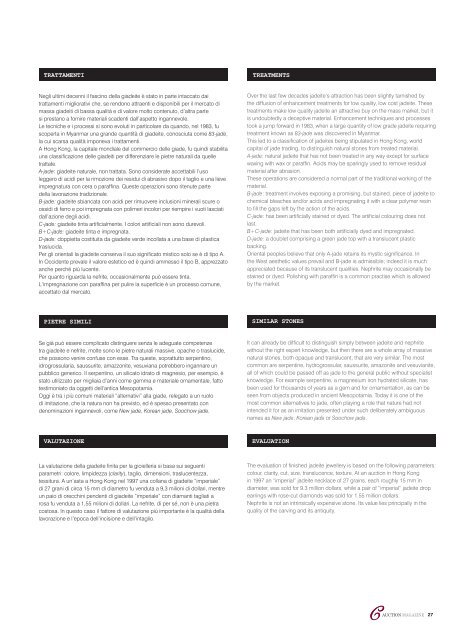You also want an ePaper? Increase the reach of your titles
YUMPU automatically turns print PDFs into web optimized ePapers that Google loves.
trAttAMenti<br />
Negli ultimi decenni il fascino della giadeite è stato in parte intaccato dai<br />
trattamenti migliorativi che, se rendono attraenti e disponibili per il mercato di<br />
massa giadeiti di bassa qualità e di valore molto contenuto, d’altra parte<br />
si prestano a fornire materiali scadenti dall’aspetto ingannevole.<br />
Le tecniche e i processi si sono evoluti in particolare da quando, nel 1983, fu<br />
scoperta in Myanmar una grande quantità di giadeite, conosciuta <strong>com</strong>e 83-jade,<br />
la cui scarsa qualità imponeva i trattamenti.<br />
A Hong kong, la capitale mondiale del <strong>com</strong>mercio delle giade, fu quindi stabilita<br />
una classificazione delle giadeiti per differenziare le pietre naturali da quelle<br />
trattate.<br />
A-jade: giadeite naturale, non trattata. Sono considerate accettabili l’uso<br />
leggero di acidi per la rimozione dei residui di abrasivo dopo il taglio e una lieve<br />
impregnatura con cera o paraffina. Queste operazioni sono ritenute parte<br />
della lavorazione tradizionale.<br />
B-jade: giadeite sbiancata con acidi per rimuovere inclusioni minerali scure o<br />
ossidi di ferro e poi impregnata con polimeri incolori per riempire i vuoti lasciati<br />
dall’azione degli acidi.<br />
C-jade: giadeite tinta artificialmente. I colori artificiali non sono durevoli.<br />
B+C-jade: giadeite tinta e impregnata.<br />
D-jade: doppietta costituita da giadeite verde incollata a una base di plastica<br />
traslucida.<br />
Per gli orientali la giadeite conserva il suo significato mistico solo se è di tipo A.<br />
In Occidente prevale il valore estetico ed è quindi ammesso il tipo B, apprezzato<br />
anche perché più lucente.<br />
Per quanto riguarda la nefrite, occasionalmente può essere tinta.<br />
L’impregnazione con paraffina per pulire la superficie è un processo <strong>com</strong>une,<br />
accettato dal mercato.<br />
pietre SiMili SiMilAr StoneS<br />
Se già può essere <strong>com</strong>plicato distinguere senza le adeguate <strong>com</strong>petenze<br />
tra giadeite e nefrite, molte sono le pietre naturali massive, opache o traslucide,<br />
che possono venire confuse con esse. Tra queste, soprattutto serpentino,<br />
idrogrossularia, saussurite, amazzonite, vesuviana potrebbero ingannare un<br />
pubblico generico. Il serpentino, un silicato idrato di magnesio, per esempio, è<br />
stato utilizzato per migliaia d’anni <strong>com</strong>e gemma e materiale ornamentale, fatto<br />
testimoniato da oggetti dell’antica Mesopotamia.<br />
Oggi è tra i più <strong>com</strong>uni materiali “alternativi” alla giade, relegato a un ruolo<br />
di imitazione, che la natura non ha previsto, ed è spesso presentato con<br />
denominazioni ingannevoli, <strong>com</strong>e New jade, Korean jade, Soochow jade.<br />
vAlUtAZione<br />
La valutazione della giadeite finita per la gioielleria si basa sui seguenti<br />
parametri: colore, limpidezza (clarity), taglio, dimensioni, traslucentezza,<br />
tessitura. A un’asta a Hong kong nel 1997 una collana di giadeite “imperiale”<br />
di 27 grani di circa 15 mm di diametro fu venduta a 9,3 milioni di dollari, mentre<br />
un paio di orecchini pendenti di giadeite “imperiale” con diamanti tagliati a<br />
rosa fu venduta a 1,55 milioni di dollari. La nefrite, di per sé, non è una pietra<br />
costosa. In questo caso il fattore di valutazione più importante è la qualità della<br />
lavorazione e l’epoca dell’incisione e dell’intaglio.<br />
treAtMentS<br />
Over the last few decades jadeite’s attraction has been slightly tarnished by<br />
the diffusion of enhancement treatments for low quality, low cost jadeite. These<br />
treatments make low quality jadeite an attractive buy on the mass market, but it<br />
is undoubtedly a deceptive material. Enhancement techniques and processes<br />
took a jump forward in 1983, when a large quantity of low grade jadeite requiring<br />
treatment known as 83-jade was discovered in Myanmar.<br />
This led to a classification of jadeites being stipulated in Hong kong, world<br />
capital of jade trading, to distinguish natural stones from treated material.<br />
A-jade: natural jadeite that has not been treated in any way except for surface<br />
waxing with wax or paraffin. Acids may be sparingly used to remove residual<br />
material after abrasion.<br />
These operations are considered a normal part of the traditional working of the<br />
material.<br />
B-jade: treatment involves exposing a promising, but stained, piece of jadeite to<br />
chemical bleaches and/or acids and impregnating it with a clear polymer resin<br />
to fill the gaps left by the action of the acids.<br />
C-jade: has been artificially stained or dyed. The artificial colouring does not<br />
last.<br />
B+C-jade: jadeite that has been both artificially dyed and impregnated.<br />
D-jade: a doublet <strong>com</strong>prising a green jade top with a translucent plastic<br />
backing.<br />
Oriental peoples believe that only A-jade retains its mystic significance. In<br />
the West aesthetic values prevail and B-jade is admissible; indeed it is much<br />
appreciated because of its translucent qualities. Nephrite may occasionally be<br />
stained or dyed. Polishing with paraffin is a <strong>com</strong>mon practise which is allowed<br />
by the market.<br />
It can already be difficult to distinguish simply between jadeite and nephrite<br />
without the right expert knowledge, but then there are a whole array of massive<br />
natural stones, both opaque and translucent, that are very similar. The most<br />
<strong>com</strong>mon are serpentine, hydrogrossular, saussurite, amazonite and vesuvianite,<br />
all of which could be passed off as jade to the general public without specialist<br />
knowledge. For example serpentine, a magnesium iron hydrated silicate, has<br />
been used for thousands of years as a gem and for ornamentation, as can be<br />
seen from objects produced in ancient Mesopotamia. Today it is one of the<br />
most <strong>com</strong>mon alternatives to jade, often playing a role that nature had not<br />
intended it for as an imitation presented under such deliberately ambiguous<br />
names as New jade, Korean jade or Soochow jade.<br />
evAlUAtion<br />
The evaluation of finished jadeite jewellery is based on the following parameters:<br />
colour, clarity, cut, size, translucence, texture. At an auction in Hong kong<br />
in 1997 an “imperial” jadeite necklace of 27 grains, each roughly 15 mm in<br />
diameter, was sold for 9.3 million dollars, while a pair of “imperial” jadeite drop<br />
earrings with rose-cut diamonds was sold for 1.55 million dollars.<br />
Nephrite is not an intrinsically expensive stone. Its value lies principally in the<br />
quality of the carving and its antiquity.<br />
27




